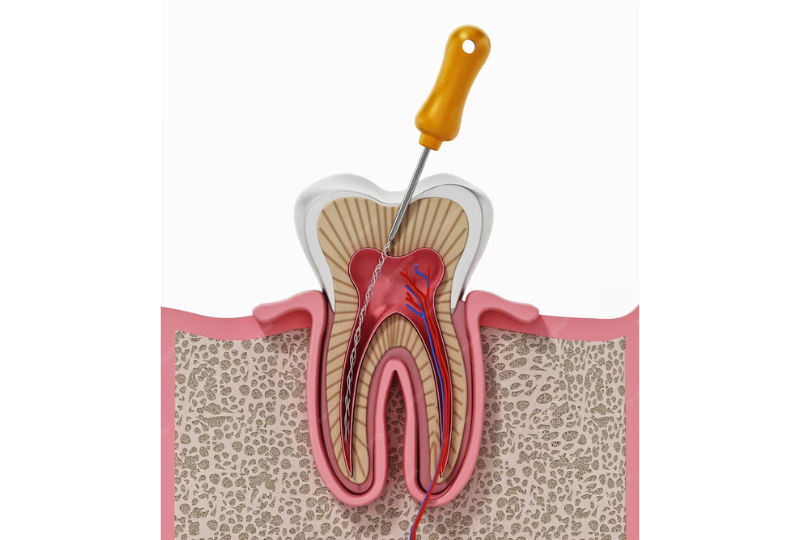Dealing with dental emergencies can be a challenging and painful experience, especially when you find yourself in need of urgent care. When a severe toothache strikes, you might wonder if an emergency root canal is required. Understanding when and why these procedures are required can empower you to make informed decisions about your dental health.
In Irving, TX, where oral health is of utmost importance, knowing how to address such situations can help you navigate dental emergencies with confidence and ensure that you receive the appropriate care when needed. So, let’s explore the when and why of emergency root canals to tackle those painful moments like a pro!
What is an Emergency Root Canal?
Imagine your tooth is in serious trouble, causing you unbearable pain! That’s when an emergency root canal superhero swoops in to save the day! This procedure is like a rescue mission for your tooth. It’s all because deep inside your tooth, there’s a hidden nerve center called the “pulp”, and when it gets invaded by nasty infections or injuries, the emergency root canal steps in to evict the villains, stop the pain, and save your tooth, almost like magic! It’s like a top-secret operation to make your tooth happy and healthy once more!
When Do Emergency Root Canals Become Necessary?
Recognizing the symptoms that indicate the need for an emergency root canal is crucial for preventing severe pain and further dental complications. Some common signs serve as clear red flags, signaling that your tooth might be in dire need of this dental superhero’s intervention. Here are some common warning signs to watch out for:
1. Unbearable Toothache
One of the most common signs is excruciating and persistent tooth pain. This pain is typically intense and unrelenting, often escalating when you apply pressure to the tooth, consume hot or cold substances, or simply chew your food. It can be a throbbing, sharp, or constant discomfort that significantly impacts your daily life.
2. Swelling and Increased Sensitivity
Swelling in the affected area and increased sensitivity in your gums can be indicative of an underlying dental issue. This combination of symptoms may be an early sign of various oral health problems, such as gum disease, dental infections, or even a dental abscess. Swelling typically occurs as a response to inflammation or infection in the gums or surrounding tissues, and it can lead to discomfort and pain.
3. Radiating Pain
Tooth pain can occasionally radiate to adjacent areas such as the ear, jaw, or neck, and this radiation of discomfort can be a telling sign of an issue within the tooth’s root. This phenomenon occurs when dental problems, such as deep cavities, dental abscesses, or infections, affect the nerve endings in the tooth, causing referred pain that can extend to surrounding structures.
4. Tooth Trauma
When you’ve undergone a traumatic injury to a tooth, such as a significant crack or fracture, it’s important to be aware that the pulp inside the tooth, which contains nerves and blood vessels, may become exposed to bacteria from the mouth. This exposure can potentially lead to an infection. An infected tooth can be very painful, cause swelling, and damage not only the tooth but also the surrounding tissues.
5. The Discoloration of the Tooth
The darkening or discoloration of a tooth can serve as a significant indicator of a potential issue with the nerve inside. When a tooth starts to appear gray or dark yellow, it often suggests a problem with the tooth’s pulp, which contains nerves and blood vessels. As the nerve inside the tooth begins to die or become compromised, it may lead to these noticeable color changes. Recognizing such discoloration is crucial, as it can be an early sign of an underlying problem that might necessitate dental treatment, such as a root canal procedure, to address the issue and preserve the tooth’s health.
The Procedure of Emergency Root Canal
When your dentist decides that an emergency root canal is required, they will start by taking X-rays to evaluate how severe the infection or damage is. The procedure typically involves the following steps:
Step 1: Anesthesia
Your dentist will administer numbing medication to the area to ensure you remain pain-free and comfortable throughout the procedure.
Step 2:Access Opening
Your dentist will create a tiny access hole in the tooth to reach the infected pulp. This opening allows them to effectively treat the affected area.
Step 3: Cleaning and Disinfecting
The dentist will carefully remove the infected pulp from the tooth, and then proceed to thoroughly clean and disinfect the interior of the tooth. This step ensures that the tooth is free from any harmful bacteria.
Step 4: Filling and Sealing
After the infected pulp is removed, the empty space is filled and the tooth is sealed to create a protective barrier, preventing any further infection or damage.
Step 5: Restoration
Typically, in most cases, a crown is placed over the treated tooth. This crown not only helps to restore the tooth’s strength but also improves its appearance, ensuring that it functions and looks like a healthy tooth once again.
Why Are Emergency Root Canals Necessary?
Emergency root canals are vital procedures that become necessary for several compelling reasons, each of which highlights their essential role in dental care. Here’s why this intervention is crucial:
1. Pain Relief
The primary goal of an emergency root canal is to alleviate severe dental pain caused by pulp infections. By taking out the damaged or infected pulp, the procedure eliminates the source of unbearable pain. This rapid pain relief is often a significant relief for patients in distress.
2. Infection Control
Dental infections, particularly abscesses, can be a source of significant concern. These infections, if left untreated, can lead to the spread of bacteria into the bloodstream and potentially affect other parts of the body. An emergency root canal helps control and prevent the infection from advancing, safeguarding both oral and overall health.
3. Tooth Preservation
By removing the pulp and sealing the tooth, it enables the preservation of the natural tooth. This preservation of the natural tooth not only safeguards your oral health but also lead to challenges associated with tooth replacement.
4. Restoration of Function
Following the completion of a root canal, the treated tooth can regain its normal functionality. You can comfortably bite, chew, and speak without the discomfort and limitations that were previously caused by a damaged or infected tooth.
After an emergency root canal, the treated tooth can regain its normal functionality. Patients can bite, chew, and speak without discomfort or limitations, which are common with a damaged or infected tooth. This restoration of function is crucial for maintaining overall quality of life.
5. Prevention of Further Complications
Failure to treat a dental infection can result in more serious issues, such as the risk of losing the affected tooth and the requirement for more extensive dental procedures. Taking swift action through an emergency root canal can help avert these upcoming difficulties and ensure long-term oral health.
Aftercare And Recovery
Following an emergency root canal, it is crucial to diligently adhere to your dentist’s post-treatment guidelines for a successful recovery. This typically involves faithfully taking any prescribed antibiotics and pain relievers to manage infection and discomfort. Additionally, it’s important to follow dietary restrictions, avoiding certain foods or habits that could jeopardize the treated tooth’s healing process. Maintaining excellent oral hygiene practices, such as gentle brushing and flossing, is essential to prevent complications. Furthermore, your dentist will schedule follow-up appointments to closely monitor your progress and ensure that the treated tooth is healing as expected, providing you with comprehensive care and support during your recovery period.
Understanding when and why you might need an emergency root canal can be your dental lifesaver guide. When your dentist shouts, “Time for a root canal!” think of it as your golden opportunity to a pain-free, hassle-free, and supercharged smile.
In Irving, TX, where emergency root canal services are readily available, residents can be confident in accessing timely and specialized treatments when needed. By recognizing the signs and knowing when and why these procedures are necessary, individuals can approach dental emergencies with a proactive mindset, addressing issues efficiently and maintaining optimal oral health. If you find yourself in need of urgent dental care, seeking professional assistance for an emergency root canal in Irving, TX, is the key to swift relief and a healthier smile.



